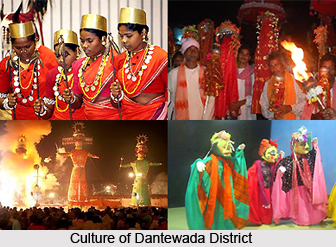Culture of Dantewada District includes the cultures and traditional customs followed by several local tribes of Dantewada. Despite being surrounded by the Indian states like Orissa and Andhra Pradesh, Dantewada has preserved its individual cultural identity. The residents of this region are generally non vegetarians. Their costumes, lifestyle and food habits, techniques of communication and folk arts of Dantewada region represent the unique appeal of the local culture of this place. Halba, Muriyas or Mariyas and Dorla constitute the many tribes of Dantewada.
The local cuisine involve liquor, rice, `Madiya`, `Paje` which is prepared from a mixture of cooked rice and water, `Landa` which is a toxic liquid made from water, `Sulphi` which is collected from palm tree, `Kosra` which is a grain like rice are the favourite foodstuffs relished by regional tribes of Damtewada District. They are not fond of wearing fashionable attires and their clothes are quite simple. Tribal women love wearing jewellery like `phuli` or a hanging nose ring made of the metals silver or gold, necklace with a garland of `karipot` or black pearl, `khinwa` or ear pots, `mahar mela` or a garland made of coins, `chudiya` or bangles made from clay, brass, silver, gold, wood or aluminium and some other Tattoos of various beautiful designs are used to decorate their bodies.
 The tribes of Dantewada District are firm believers in Gods and Goddesses, `Bhooth-Peth` or evil spirits, `Jhad Phook` or the practise of exorcism, `Sirha Guniya`, `Jadu Tona` or black magic, `Panjiyan-Perma` or the practise of various kinds of rituals and worships, `Tantra-Mantra` or incarnation and many others. These tribes celebrate numerous festivals like Diwali, `Goncha` or Rath Utsav, Holi, Fagun, Dussehra, Pandum and some others. Several kinds of marriages are held amongst the tribals of Dantewada District like `Dharjiya Vivah`, `Vridh Vivah`, `Bahu-Vivah`, `Apharan-Vivah`, etc. Mahla Jane is yet another form of marriage which is prevalent here. The social occasion called `Chatti` is celebrated to mark childbirths by the local tribes of Dantewada District. They have a tradition of burning the human corpses. However, little children are mostly buried. The `Sutal` custom is also followed wherein the close relatives of the departed people dissociate themselves from social gatherings.
The tribes of Dantewada District are firm believers in Gods and Goddesses, `Bhooth-Peth` or evil spirits, `Jhad Phook` or the practise of exorcism, `Sirha Guniya`, `Jadu Tona` or black magic, `Panjiyan-Perma` or the practise of various kinds of rituals and worships, `Tantra-Mantra` or incarnation and many others. These tribes celebrate numerous festivals like Diwali, `Goncha` or Rath Utsav, Holi, Fagun, Dussehra, Pandum and some others. Several kinds of marriages are held amongst the tribals of Dantewada District like `Dharjiya Vivah`, `Vridh Vivah`, `Bahu-Vivah`, `Apharan-Vivah`, etc. Mahla Jane is yet another form of marriage which is prevalent here. The social occasion called `Chatti` is celebrated to mark childbirths by the local tribes of Dantewada District. They have a tradition of burning the human corpses. However, little children are mostly buried. The `Sutal` custom is also followed wherein the close relatives of the departed people dissociate themselves from social gatherings.
Animal husbandry, farming and poultry farming constitute the regular occupations of the residents of the district of Dantewada District. Forest products like fruits, `datun` or toothbrush, leaves, firewood, baskets, `soop` or gadgets utilized for winnowing foodgrains, `Chati`, `Boda`, `Dhup` or incense sticks, and many items made from bamboo are sold as a part of their livelihood.
Folk songs of Dantewada District are cherished by the local people and involve Mariro, Leja, Jhaliyana Geet, Dhankul Geet, Reelo, Kotni, Chait Parab Geet and others. There are different types of dances which are practiced which include Gedi, Karsad, Dandari, Gurgal, Dandami-Maria, etc while the many folk dramas are Dandari, Giti, Bhatra. The `Murga Ladai` is another form of entertainment for the local men folk which implies cock fights. In these fights, sharp knives are tied to the legs of the cocks and betting is performed on the winner. The multiple forms of arts consist of bamboo, metals, clay and stone. The other forms of art are Gharwa art, wooden art and other types of crafts include those using peacocks and shells.
Aboojhmarhi, Bhatri, Parji, Damdami and Dharvi are the many local dialects used in Dantewada. Religious deities worshipped here are Bhairam Dev, Mawli Mata, Ghat Dev, Seethla Devi, Aanga Dev, Bhima Dev, Danteshwari and others. Nature worship is also performed by the tribal people.






